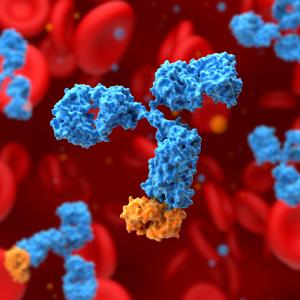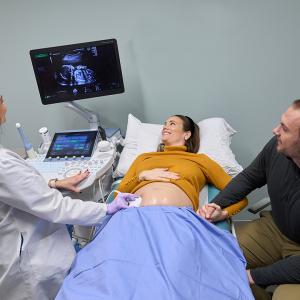
Dr. Ashira Blazer
Photo: Juliana Thomas
Three major achievements in 2018 illustrate how NYU Langone Health investigators are parlaying ambitious collaborations into significant advances in systemic lupus erythematosus and lupus nephritis research.
Understanding Increased Lupus-Associated Renal Disease and Mortality Risk in Ghanaian Patients
Lupus is far more common and more severe in its manifestations among people of African ancestry than among their Caucasian counterparts. Ashira Blazer, MD, assistant professor of medicine, is investigating this disparity from the vantage point of two specific Apolipoprotein L1 (APOL1) polymorphisms, G1 and G2, in the risk for lupus-related poor outcomes.
“Genetic variation at APOL1 are conserved in people of predominantly West and Central African ancestry because they provide an evolutionary advantage in resisting African trypanosomiasis,” Dr. Blazer says. Her latest research, however, suggests that the APOL1 polymorphisms carry the considerable downside of heightened risk of progressive renal disease, organ damage accrual, and mortality among Ghanaian patients with lupus.
Working with collaborators in Ghana, Dr. Blazer followed more than 100 people who have lupus at Korle-Bu Teaching Hospital in Accra and genotyped them for APOL1 to determine whether their genetic polymorphism influenced their outcome. This opportunity, along with a recently launched collaboration in Nigeria, will allow her to include APOL1 and genetic association for the global lupus phenotype.
“What we’ve shown so far is that patients with the polymorphisms do in fact progress to end-stage renal disease at a much faster rate, and overall these polymorphisms are associated with damage accrual in lupus and premature mortality,” Dr. Blazer says. In the cohort, about 25 percent of the Ghanaian patients who were homozygous for risk-variant alleles have succumbed to lupus-associated end-stage renal disease or heart failure, compared with 2 percent of heterozygous variant carriers or those with wild type alleles.
Fortunately, Dr. Blazer says, strategic interventions that require just a few additional resources may help prevent considerable morbidity and mortality. Adding educational materials, a trained nurse, and laboratory technician in Ghana, for instance, has improved patients’ drug adherence and attendance at follow-up appointments.
Preventing Neonatal Lupus Rash with Hydroxychloroquine
Peter M. Izmirly, MD, assistant professor of medicine, leader of the Manhattan Lupus Surveillance Program (MLSP), a population-based lupus registry, has recently focused on the benefits and limitations of hydroxychloroquine, known as Plaquenil, a widely used medication by patients who have lupus with utility to hold ongoing disease in check. Dr. Izmirly reasoned that another use might benefit prelupus women at risk for a pregnancy complication of neonatal lupus.
His group’s research first suggested that mothers with systemic lupus erythematosus and antibodies to SSA/Ro (a risk factor for the development of neonatal lupus in an offspring) who take hydroxychloroquine may be at reduced risk for having a child with cardiac manifestations of neonatal lupus. In a subsequent study, Dr. Izmirly and colleagues showed that hydroxychloroquine could likewise decrease the recurrence rate of neonatal heart block in subsequent children born to at-risk mothers with lupus or Sjogren’s syndrome or even those with no rheumatic disease. Those results led to an ongoing prospective study to test the drug’s benefits in a larger cohort.
“But there are other manifestations of neonatal lupus,” Dr. Izmirly says. “Skin manifestations are not as serious as the cardiac manifestation but do come with their own complications, such as potential scarring.” By pooling resources and data with collaborators in Toronto and Paris, Dr. Izmirly’s group led a retrospective study examining the ability of hydroxychloroquine to prevent neonatal lupus rash.
The study, recently published in the Annals of Rheumatic Disease, included 262 children who developed the rash after birth and 434 children who remained healthy despite exposure to the same autoantibodies among mothers with an autoimmune disease. Those who stayed on hydroxychloroquine throughout their pregnancy gave birth to children who were significantly less likely to develop a rash than children born to mothers who didn’t take the drug.
The roughly 60 percent risk reduction held up for mothers with a lupus diagnosis and was even stronger among infants examined within a month of their birth, when they would be more likely to retain some of the drug in their system. “No matter how we looked at it, the data suggested that hydroxychloroquine reduces the risk,” Dr. Izmirly says.
Doctors commonly prescribe the drug to prevent lupus flares during pregnancy. “So this is more evidence to suggest that there are additional benefits of hydroxychloroquine. Especially if mothers have the candidate autoantibodies that put their child at risk for neonatal lupus,” says Dr. Izmirly.
Mapping the Cellular Landscape of Lupus Nephritis
Treatment decisions in lupus nephritis are still based primarily on renal histology. Collaboration with researchers Tom Tuschl, PhD, Rockefeller University, and Chaim Putterman, MD, Albert Einstein College of Medicine, in the National Institutes of Health (NIH)–supported Accelerating Partnerships in Medicine, suggests that single-cell RNA-seq (scRNA-seq) analysis may offer more detailed insights into the disease’s genesis, better categorization of pathologic subtypes, and clearer information on which to base prognosis and treatment decisions.
The NYU Langone portion of the multicenter collaboration was led by Jill P. Buyon, MD, the Sir Deryck and Lady Va Maughan Professor of Rheumatology, and coinvestigator Robert Clancy, PhD, professor of medicine. The researchers conducted scRNA-seq on kidney biopsy tissue collected from nine patients with lupus nephritis and two healthy transplant donors.
By capturing single renal cells from the tissue samples, sequencing their cDNA, and aligning the sequences to the human reference genome, the team generated a gene expression matrix and transcriptome profile for each cell. For example, differential gene expression analysis and cell lineage markers revealed elevated levels of interferon response genes in the collecting duct cells and distal convoluted tubule cells, and endothelial cells of lupus nephritis patients.
In the lupus nephritis samples, the impact of disease was widespread including the expression of fibrotic factors by nonimmune cells, such as the collecting duct cells, distal convoluted tubule cells. Within reach, there will be an association of expression by a panel of genes and an outcome for the course of aggressive lupus nephritis with utility to guide the choice of therapeutic intervention.
“This single-cell sequence analysis of renal biopsy tissue from patients with lupus nephritis has helped us create a cellular atlas that could be invaluable to studying the disease’s heterogeneity,” says Dr. Clancy.

